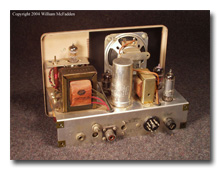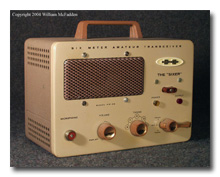
by William Eric McFadden
From the HW-29A manual:
-
The Heathkit Model HW-29A Transceiver is a combination transmitter and receiver for use in the 6-meter amateur radiotelephone service.Extensive proofbuilding and field testing over a period of several months have provided conclusive evidence that the HW-29A Transceiver will provide highly reliable service in its intended application, if assembled, wired and adjusted in accordance with the instructions outlined in this manual. It is, therefore, recommended that you follow the instructions carefully and make full use of the Circuit Description, Block Diagram, Schematic Diagram, Installation Information, etc., in the interest of acquiring a good understanding of the transceiver and its capabilities.The HW-29A Transceiver has a self-contained power supply for operation from a 117 volt 50/60 cycle AC power line, or can be operated from either a 6 volt or a 12 volt battery by using an external power supply having a rating of 260 volts B+ at 90 ma.The HW-29A can be used with a wide variety of antenna types; an antenna should be selected for the transceiver on the basis of the application involved.
Specifications: Transmitter Section Power Input to Final RF Amplifier: Approximately 5 watts Frequency Control: 8.33 mc to 9.000 mc crystal
Pin spacing .500"
Pin diameter .093"
FT-241 or FT-243 crystal holderModulation: AM plate modulation, automatically limited to
not more than 100%Output Impedence: 50 or 72 ohm Receiver Section Receiver Type: Superregenerative detector preceded by RF preamplifier stage Sensitivity: Usable with signals as low as 1 microvolt at the antenna terminals Speaker Size: 3-½" round Tuning Range: 50 mc to 54 mc Power Supply Power Rectifier: Two silicon diodes in full-wave voltage doubler cicuit Power Requirements: With built-in supply:
105-125 volts 50/60 cycle AC 45 watts
With external supply:
6 volt operation -- 6 volts at 2.35 amps, 260 volts DC at 90 ma.
12 volt operation -- 12 volts at 1.2 amps, 260 volts DC at 90 maAccessories Microphone: Ceramic element type, plastic case. Suitable for either hand or desk operation Connecting Cables: Two supplied, one for 105-125 volt AC operation and one for 6 or 12 volt external DC power supply use. Power circuits are automatically switched for internal or external power supply use when cable is plugged in General Tube Complement: 1 - 6BA8: Oscillator/Tripler (Pentode Section) Doubler (Triode Section)
1 - 6CL6: Final RF Amplifier
1 - 6AN8: Receiver Preamplifier and Detector
1 - 12AX7: Speech Amplifier and First Audio Amplifier
1 - 6AQ5: Audio Output and ModulatorCabinet Dimensions: 8" high (including handle)
6" deep (including knobs)
9-¾" wide (including license holder)Net Weight: 6-½" lbs Shipping Weight: 10 lbs
The HW-29/HW-29A "Sixer" 6 meter AM transceiver was offered by Heathkit in the early to late 1960s. The transceiver features a tunable superregenerative receiver and crystal-controlled transmit. Transmit output is about 2 watts. The price for the basic transceiver appears to have remained $44.95 over the entire period the transceiver was available.
 I bought this HW-29 in order to participate in the Athens County Amateur Radio Association's
weekly 6m AM vintage-rig net. I was fortunate in that this found-on-eBay rig was very clean
and worked well right off the bat. I suspected that my Sixer is an older HW-29 and not the
later HW-29A, and this has been confirmed. (Thank you, Eric Mynes, KC8WZB.) The front-panel
crystal socket and rear-panel SO-239 on my Sixer are modifications installed by a previous owner.
I bought this HW-29 in order to participate in the Athens County Amateur Radio Association's
weekly 6m AM vintage-rig net. I was fortunate in that this found-on-eBay rig was very clean
and worked well right off the bat. I suspected that my Sixer is an older HW-29 and not the
later HW-29A, and this has been confirmed. (Thank you, Eric Mynes, KC8WZB.) The front-panel
crystal socket and rear-panel SO-239 on my Sixer are modifications installed by a previous owner.
It took me a while to find a microphone suitable for this rig. The best audio so far has been provided by a Kobitone 25LM025 12k-ohm crystal microphone element (datasheet). (Thanks go to NS8O for providing this mic element.)
The Benton Harbor Lunch-boxes were designed to be portable rigs, but operation away from commercial mains required the use of a power supply capable of providing 260vdc. Heathkit's solution was the GP-11 vibrator power supply. Nowadays, however, we have other options. I have a 75-watt DC-to-AC inverter by APC that nicely powers the Sixer from a 12vdc battery. I have operated the rig powered by this inverter during a power outage. Reports were that both my signal and my audio were clean and sounded good; I noticed a slight decrease in transmit power, and the receiver had slightly more noise.
Using this simple but effective rig while participating in the ACARA's weekly "5pm 6AM" net on 50.4mc has been a great deal of fun. I enjoy feeling the warmth of the chassis and seeing the gentle glow from within the cabinet.
Advertisements:
"Benton Harbor Lunch-box" Links:
- HW-29A at rigpix.com
- HW-19, HW-29A, & HW-30 at the Heathkit Virtual Museum
- The following articles are available to ARRL members; search the QST Archives:
- Beginner and Novice: Some Useful Modifications for the Sixer and Twoer,
by Lew McCoy, W1ICP (May, 1968 QST) - Hints and Kinks: Final Tuning Knob for the Heath "Sixer",
by Frank Wing, W4TUO (January, 1967 QST) - Hints and Kinks: Twoer or Sixer Band Monitor,
by Bruce Block, K2YSN (April, 1963 QST) - Hints and Kinks: Notes on the Heath "Sixer",
by Mason Southworth, W1VLH (October, 1960 QST) - Hints and Kinks: Notes on the Heath "Sixer",
by Harry Perry, W9AMH (October, 1960 QST) - Hints and Kinks: Notes on the Heath "Sixer",
by Chester Smith, K1CCL (October, 1960 QST)
Attributions:
- 1961 catalog page found at Technology Systems.
- 1963 catalog page found at Technology Systems.
- 1967 QST advertisement found online; source lost.
